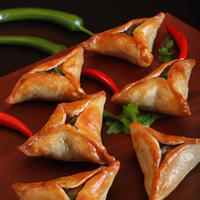
1 serving (100 grams) contains 260 calories, 6.0 grams of protein, 12.0 grams of fat, and 30.0 grams of carbohydrates.

Log this food in SnapCalorie

Nutrition Information
Calories |
619.0 | ||
|---|---|---|---|
% Daily Value* |
|||
| Total Fat | 28.6 g | 36% | |
| Saturated Fat | 7.1 g | 35% | |
| Polyunsaturated Fat | 0 g | ||
| Cholesterol | 23.8 mg | 7% | |
| Sodium | 714.3 mg | 31% | |
| Total Carbohydrates | 71.4 g | 25% | |
| Dietary Fiber | 4.8 g | 17% | |
| Sugars | 4.8 g | ||
| protein | 14.3 g | 28% | |
| Vitamin D | 0 mcg | 0% | |
| Calcium | 95.2 mg | 7% | |
| Iron | 3.6 mg | 20% | |
| Potassium | 357.1 mg | 7% | |
* Percent Daily Values are based on a 2,000 calorie diet. Your daily values may be higher or lower depending on your calorie needs.
Food Attributes
Source of Calories
About Sambusak
Sambusak, a popular pastry in Middle Eastern and Mediterranean cuisine, is a savory turnover typically filled with spiced ingredients like ground meat, lentils, cheese, or vegetables. Its origins date back centuries, with variations found in Iraqi, Syrian, and Jewish culinary traditions. The dough is made from flour, water, and oil or butter, giving it a flakey texture when baked or fried. While Sambusak offers protein and fiber depending on the filling, it can be calorie-dense due to its refined flour and fat content. Some versions are fried, increasing saturated fat and calories, though baked alternatives offer a healthier option. Sambusak is often enjoyed as an appetizer or snack, blending rich flavors and cultural heritage in a compact, satisfying parcel. Opt for whole-grain dough and lean protein fillings to enhance its nutritional value while savoring its timeless taste.



